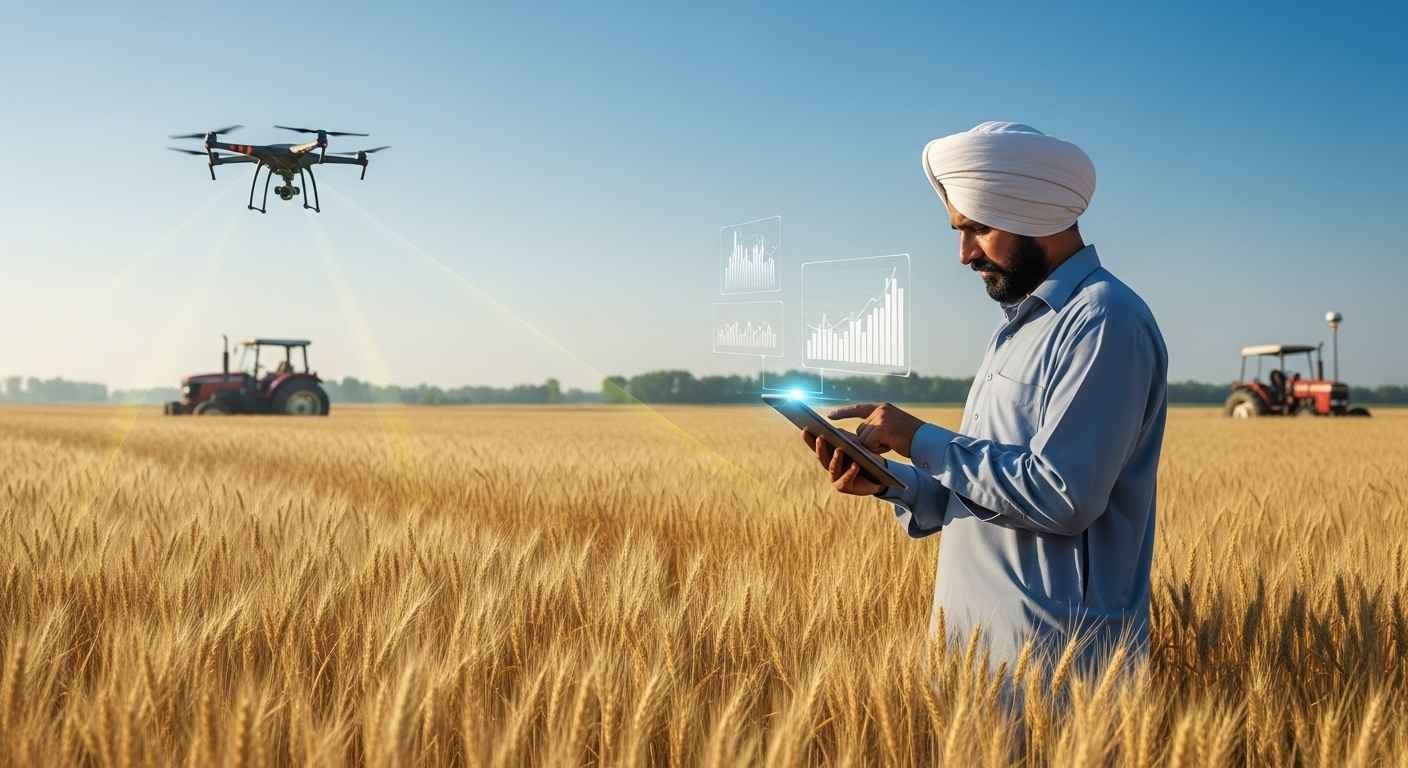Agriculture remains the backbone of Pakistan’s economy—employing over 37% of the workforce and contributing around 19% to GDP. Yet, yield inefficiency and outdated methods continue to limit potential. This Beginner’s Guide to Farm Yield Optimization explains how farmers can harness modern tools, data-driven decision-making, and youth-led tech innovation to increase productivity sustainably.
From digital calculators to government-supported programs, this guide outlines how technology and training can revolutionize how we grow food.
Understanding Farm Yield Optimization
Quick Answer: Farm yield optimization is the process of maximizing crop output using better data, technology, and management practices.
Farm yield optimization blends traditional farming wisdom with modern precision agriculture. It’s about using real-time data, weather forecasts, and digital analytics to make informed decisions on soil health, irrigation, and fertilizer use.
Key factors influencing yield:
-
Soil quality and nutrient balance
-
Water management and irrigation scheduling
-
Pest control and disease management
-
Crop rotation and diversification
-
Data-driven monitoring and forecasting
Countries like India, the UK, and Pakistan are already integrating such methods through rural tech programs and youth-driven agri-startups.
Importance of Data-Driven Agriculture
Quick Answer: Data-driven farming helps farmers make precise, evidence-based decisions that directly improve productivity.
In today’s digital era, successful farming depends on data analytics—from soil testing to satellite mapping. Tools like the Crop yield estimation calculator allow farmers to predict expected yields based on soil type, rainfall, and planting density.
Benefits of data-driven agriculture:
-
Reduces input waste (fertilizer, water, seeds)
-
Enhances yield accuracy
-
Supports sustainable farming practices
-
Helps access microfinancing and insurance
For example, in Punjab, farmers adopting data-backed practices have reported yield improvements of up to 20% in wheat and sugarcane crops.
Precision Agriculture: A Game Changer
Quick Answer: Precision agriculture uses technology to optimize every aspect of farming—from seed to harvest.
Technologies such as GPS-guided tractors, drone mapping, and IoT-based soil sensors are transforming agriculture in Sindh and Balochistan. Precision tools help monitor real-time soil moisture, predict weather conditions, and manage inputs efficiently.
Examples of precision tools:
-
Soil moisture sensors
-
Drone-based imaging for crop health
-
GPS-controlled irrigation systems
-
Automated fertilizer applicators
According to FAO, precision agriculture can reduce water usage by up to 30% while increasing productivity by 15–25%.
Role of Government and Youth in Agri-Tech
Quick Answer: National programs and youth entrepreneurship are driving digital transformation in agriculture.
The Government of Pakistan’s Prime Minister’s Youth Program (PMYP) and National Agriculture Emergency Program aim to empower young agri-entrepreneurs. Initiatives include:
-
Digital agriculture training hubs in Punjab and KPK
-
Agri-tech incubation centers in collaboration with universities
-
Subsidized smart irrigation and drone programs
These programs encourage innovation in crop monitoring and data analytics, fostering the next generation of smart farmers.
Best Tools and Platforms for Farm Management
Quick Answer: Digital calculators and online platforms make it easy to estimate yields, plan budgets, and track expenses.
For beginners, using free online calculators for everyday use simplifies complex farm decisions. Whether calculating rainfall averages, fertilizer ratios, or expected yields—these tools empower farmers to manage efficiently without costly software.
Useful calculator types:
-
Crop yield and irrigation calculators
-
Fertilizer and cost estimators
-
Weather and harvest predictors
These accessible tools are designed for farmers, students, and agri-consultants alike, providing real-time insights for better planning.
Case Study: Wheat Yield Improvement in Punjab
Quick Answer: Precision and digital methods helped increase wheat yield by over 25% in certain regions of Punjab.
A pilot project launched by Punjab Agriculture Department introduced soil-testing sensors and drone-assisted crop monitoring across 500 farms. Results showed:
-
25% increase in wheat yield
-
15% reduction in water wastage
-
Higher profit margins per acre
Farmers trained under youth-focused programs were more adaptive to new tools, highlighting the need for continued digital literacy in agriculture.
Overcoming Common Challenges in Yield Optimization
Quick Answer: Education, affordable access, and local adaptation are key to success in yield optimization.
Farmers face barriers like lack of data literacy, equipment costs, and limited access to broadband internet in rural zones. The solution lies in:
-
Government-supported digital inclusion programs
-
Community training centers
-
Local partnerships with agri-tech startups
The Agriculture Department of Sindh is already collaborating with universities to train local youth on digital monitoring systems.
How IT Companies Are Powering Agri-Tech Growth
Quick Answer: Tech firms are driving digital transformation in Pakistan’s farming sector.
The fastest growing IT company in Pakistan is developing platforms that integrate real-time farm analytics, IoT sensors, and AI models to predict crop health. Such companies provide backend systems for weather forecasting and supply chain optimization, linking farmers to smarter marketplaces.
Their innovations not only boost agricultural output but also create thousands of jobs in rural IT sectors—aligning with the government’s Digital Pakistan Vision.
Sustainability and Climate-Smart Farming
Quick Answer: Climate-smart agriculture helps farmers adapt to climate change while maintaining yield stability.
As global temperatures rise, climate-smart practices like drip irrigation, crop rotation, and organic soil enrichment have become vital. Programs like UN FAO’s Climate-Smart Agriculture Initiative in Pakistan are helping rural farmers reduce emissions and build resilience.
Key climate-smart tactics:
-
Using drought-resistant seeds
-
Rotating crops to balance soil nutrients
-
Leveraging renewable energy for irrigation
Sustainability ensures long-term soil fertility and food security for future generations.
Future of Farming: AI, IoT, and Big Data
Quick Answer: The next era of farming will be dominated by automation, sensors, and predictive analytics.
AI-powered models can now forecast yield outcomes and detect crop diseases early. IoT devices track soil health remotely, while big data platforms integrate weather patterns with crop cycles.
Emerging trends:
-
AI-driven pest detection
-
Blockchain for supply chain transparency
-
Cloud-based irrigation management systems
These innovations will redefine agriculture in regions like South Punjab and Northern Sindh, ensuring farmers can produce more with fewer resources.
FAQs
Q1. What is the easiest way to calculate farm yield?
A: Use a crop yield estimation calculator online for quick results based on planted area, row spacing, and harvest data.
Q2. Can digital tools help small farmers in Pakistan?
A: Yes, tools like free online calculators and mobile apps are built to support small-scale farmers in rural areas.
Q3. What government programs support young agri-entrepreneurs?
A: Initiatives like PMYP and National Agriculture Emergency provide training, tools, and subsidies for youth in agriculture.
Q4. Is precision farming expensive?
A: Initial setup can be costly, but long-term savings in water, fertilizer, and labor often outweigh the investment.
Q5. Which regions in Pakistan are leading in digital agriculture?
A: Punjab and Sindh are at the forefront due to strong government support and private sector involvement.
Q6. How does technology reduce farming risk?
A: Predictive tools and AI monitoring help forecast diseases, weather impacts, and optimize resource use.
Q7. What’s the role of IT parks in agriculture?
A: They develop software, analytics systems, and AI tools that enhance yield forecasting and farm management.
Final Thought
As a tech writer observing Pakistan’s agricultural transformation, I believe digital innovation is the bridge between traditional farming and future food security. Tools like crop calculators, youth-driven programs, and IT initiatives are redefining how farmers think about yield and efficiency.
Regions like Punjab and Sindh show that when technology meets tradition, progress follows. The next generation of farmers won’t just grow crops—they’ll grow data, sustainability, and opportunity.




